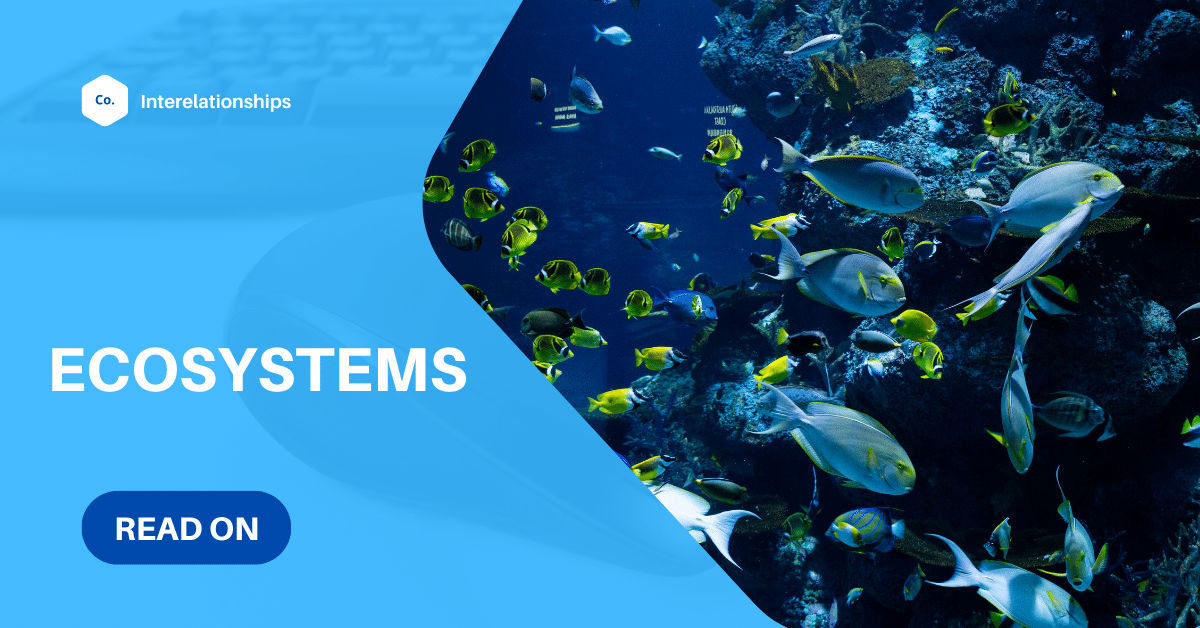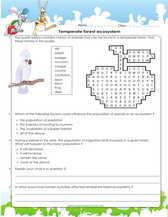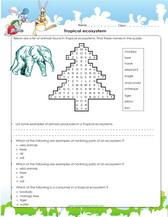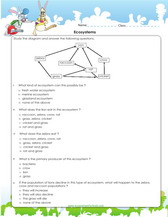Ecosystems, games, worksheets, quizzes for kids
Ecosystems, games, worksheets, quizzes for kids, learn about consumer, producers, decomposer, feeding relationships. Science activities for 1st, 2nd, 3rd, 4th and 5th grades. An ecosystem if often defined as a relationship between living organisms with the living and nonliving parts of their surounding and the exchanges of materials that take place during this process. The primary source of energy in an ecosystem is the sun while green plants are the main source of conversion of sunlight into food that can be consumed by other organisms. Usually, the nonliving parts of an ecosystem are also very important e.g. the soil stores minerals and water which plants need. The air we breathe is also and important nonliving part of an ecosystem. There are different types of ecosystems e.g. tropical, temperate, aquatic, grassland ecosystems. Each is unique in its animal species and environment. This page features some pdf printable tests for kids on ecosystems. Ecosystem worksheet
Ecosystems for Kids - Why Are Ecosystems Important?
Ecosystems consist of all living organisms in a physical environment. They are connected by energy flows and nutrient cycles. Photosynthesis is the process by which sunlight is absorbed by plant tissue and converted into chemical energy. This chemical energy is then absorbed into plant tissues. This cycle repeats itself over and over again. The result is a continuous system of interconnected parts.
The basic idea behind ecosystems is that everything is connected. They are based on the interdependence of organisms and their environment. We are constantly consuming resources and compromising the health of our planet. Some of our destructive practices result in deforestation, loss of pollination in plants, water pollution, soil depletion, overfishing, and tremendous loss of biodiversity. These effects may be invisible, but they are nevertheless harmful to ecosystems.
Therefore, we must preserve these natural ecosystems to ensure that they can continue to meet the needs of our species. If the current generation fails to do so, it will compromise the ability of future generations to benefit from the same resources.
The protracted destruction of ecosystems is unsustainable. Despite the obvious costs of human activities, these ecosystems sustain millions of species. Our species' escapades threaten human health, and if they continue, humanity will not be able to meet their needs in the future. The destruction of these systems will lead to the extinction of many species and an overall decline in biodiversity. Our demands on the earth's resources do not stop there.
In addition to human needs, ecosystems sustain other life forms. Animals are also essential to human survival. In contrast, human needs rob the ecosystem of the energy and resources it needs to sustain itself. Therefore, a balanced ecosystem is essential for humans and for their survival. It supports a wide variety of species. For example, if a farmer kills all the wolves in an area to protect his livestock, the ecosystem is destroyed because in the event of an increase in destructive rodents, the control mechanism is lost. The farmer may not even be able to grow crops in that area subsequently.

As the demand for resources and food increases, so do the risks to our ecosystems. These activities have a negative impact on ecosystems. Ultimately, they have no tangible benefit and can only harm the environment. So we need to protect our environment in order to sustain our existence. We need to protect the ecosystems that support us.
While the benefits of protecting ecosystems are easy to see, the downside is that they are not able to provide immediate benefits. However we have to see that these ecosystems are critical to our wellbeing. They support the economy and human needs, but they are unable to sustain themselves without our help. They also ensure that people's livelihoods are sustainable.
Fortunately, saving ecosystems has many benefits. For example, people have discovered that rainforest plants are a valuable resource for people through the timber they provide; they are also a source of many medicines, including quinine and curare, which are widely used today. However, to protect these plants, rainforest ecosystems must be preserved. If we lose our rainforest, we can no longer benefit from these medicines.
In an ecosystem, all living organisms interact with each other. For example, plants need sunlight and soil, while animals need fresh air and clean water. They are also important to the environment because they help keep the temperature and humidity stable. In an ecosystem, these interactions are essential for organisms to live and can be beneficial or detrimental depending on how the interactions go.
Ecosystems are clearly essential for life to exist the way we know it. It is therefore important for humanity to come together to identify strategies to preserve global ecosystems.
What are the 4 types of ecosystems?
Ecosystems are complex systems consisting of living organisms, their physical surroundings, and the interactions between them. They are essential for sustaining life on Earth, as they provide a range of ecosystem services such as food, clean water, and air, as well as cultural and recreational opportunities. Ecosystems can be classified into four major types based on their characteristics and the types of organisms that live within them. These are terrestrial, aquatic, desert, and grassland ecosystems.
Terrestrial Ecosystems:
Terrestrial ecosystems are land-based ecosystems that can be found on every continent on Earth. They are characterized by their soil, vegetation, and climate, which vary widely depending on their location. Terrestrial ecosystems can support a diverse range of plant and animal life, from the Arctic tundra to tropical rainforests. The major types of terrestrial ecosystems are forests, grasslands, tundra, and deserts.
Forests are the most widespread type of terrestrial ecosystem, covering approximately 30% of the Earth's land surface. They are characterized by their dense tree cover and a variety of other plant species. Forests provide important ecosystem services, including carbon sequestration, nutrient cycling, and habitat for many species. Forests can be further classified into several types, including tropical rainforests, temperate deciduous forests, and boreal forests.
Grasslands are characterized by their grassy vegetation and lack of trees. They can be found in areas with moderate rainfall and moderate temperatures, such as the Great Plains of North America and the African savannah. Grasslands are home to a diverse range of grazers, including bison, zebras, and antelopes. They also play a critical role in carbon sequestration and soil stabilization.
Tundra is a type of terrestrial ecosystem characterized by its cold, harsh climate and a lack of trees. Tundra ecosystems can be found in the Arctic and Antarctic regions and on high mountains. The vegetation in tundra ecosystems consists mainly of low-growing shrubs, grasses, and mosses. Tundra ecosystems play an important role in carbon sequestration and are also important breeding grounds for migratory birds.
Deserts are a type of terrestrial ecosystem characterized by their extreme aridity and sparse vegetation. They can be found in regions such as the Sahara, the Mojave Desert, and the Australian Outback. Deserts are home to a variety of specialized plant and animal species adapted to the harsh conditions, including cacti and camels. Deserts are also important for mineral extraction and renewable energy production.
Aquatic Ecosystems:
Aquatic ecosystems are water-based ecosystems that can be found in oceans, lakes, rivers, and wetlands. They are characterized by their water chemistry, temperature, and current patterns, which influence the types of organisms that live within them. Aquatic ecosystems are home to a wide range of aquatic plant and animal species and are important for a range of ecosystem services, including water filtration, nutrient cycling, and carbon sequestration.
The major types of aquatic ecosystems are marine, freshwater, and estuarine ecosystems. Marine ecosystems are the largest ecosystems on Earth and are characterized by their saltwater environment. They can be found in the open ocean, as well as near the coastlines and in intertidal zones. Marine ecosystems are home to a wide range of plant and animal species, including phytoplankton, seaweed, fish, and whales.
Freshwater ecosystems are characterized by their low salt content and include rivers, lakes, and wetlands. They are home to a diverse range of aquatic plant and animal species, including fish, amphibians, and waterfowl. Freshwater ecosystems play a critical role in providing clean water and supporting fisheries.
Estuarine ecosystems are where freshwater and saltwater ecosystems meet and mix, and they are characterized by their high productivity and unique environmental conditions. Estuaries are home to a range of plant and animal species adapted to the fluctuating salinity levels and tidal cycles, including salt marsh grasses, crabs, and clams.
Desert Ecosystems:
Desert ecosystems are characterized by their extreme aridity and sparse vegetation. They can be found in regions such as the Sahara, the Mojave Desert, and the Australian Outback. Deserts are home to a variety of specialized plant and animal species adapted to the harsh conditions, including cacti and camels. Deserts are also important for mineral extraction and renewable energy production.
Desert ecosystems are some of the most extreme environments on Earth, with very little rainfall and extreme temperatures. Because of these harsh conditions, only a limited number of plant and animal species can survive in these areas. In desert ecosystems, plants have developed various adaptations, such as having long roots to reach deep underground water sources, or having waxy leaves to reduce water loss. Animals in desert ecosystems have also developed various adaptations, such as the ability to go for long periods without water, or having large ears to dissipate heat.
Grassland Ecosystems:
Grasslands are characterized by their grassy vegetation and lack of trees. They can be found in areas with moderate rainfall and moderate temperatures, such as the Great Plains of North America and the African savannah. Grasslands are home to a diverse range of grazers, including bison, zebras, and antelopes. They also play a critical role in carbon sequestration and soil stabilization.
Grassland ecosystems are some of the most productive ecosystems on Earth, supporting a wide range of plant and animal species. The grasses in these ecosystems have deep roots that help retain soil moisture and prevent erosion. The grazers that feed on these grasses also help to maintain the grassland ecosystem, by keeping the grasses trimmed and promoting new growth.
In conclusion, ecosystems are complex systems that play a critical role in sustaining life on Earth. They can be classified into four major types based on their characteristics and the types of organisms that live within them. Terrestrial ecosystems include forests, grasslands, tundra, and deserts, while aquatic ecosystems include marine, freshwater, and estuarine ecosystems. Each type of ecosystem has its unique characteristics and provides a range of ecosystem services that are essential for supporting life on Earth. By understanding these ecosystems and their functions, we can work to protect and preserve them for future generations.




